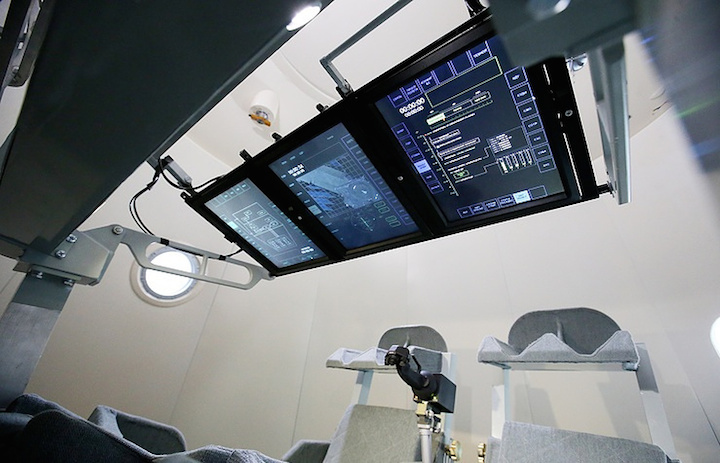29.03.2017
The new spacecraft will be able to stay in flight on its own for up to 30 days
MOSCOW, March 28. /TASS/. Russia’s future spacecraft 'Federation' will be equipped with a full-size toilet cabin, well isolated from the other compartments, the chief of the flight test department at the space rocket corporation Energiya, Mark Serov, has told TASS in an interview.
"We are to create an area that guarantees true privacy, something which a curtain is unable to provide. Joking aside: comfort in space is essential. In comfortable conditions crewmembers work more effectively, and effective work is crucial to flight safety. For the toilet cabin we will use a new design concept and proper materials. Currently we are in the mock-up design and 3D modelling phase," he said.
The 'Federation' spacecraft, being designed by the space rocket corporation Energiya, is meant for delivering payloads - crews of four astronauts and supplies to orbits around the Earth and also to the Moon.
The spacecraft will be able to stay in flight on its own for up to 30 days or, if docked with an orbital station, up to one year. Heavy rockets Angara-A5B and Angara-A5P will be used to put 'Federation' in space.
---
Humans, however, won’t be excluded from the spaceship's control system just yet

MOSCOW, March 28. /TASS/. Russia’s new spacecraft 'Federation' intended for near-Earth flights and lunar missions will be controlled by an onboard digital computer network whose failure is ruled out, Head of the Flight Test Center at Energiya Space Rocket Corporation Mark Serov told TASS.
Energiya Space Rocket Corporation is the developer of the new spacecraft Federation.
"Federation’s onboard computer system has profound redundancy and therefore the computer network’s failure is something unthinkable. There will be just few push buttons aboard (following the tradition inherited from Soyuz spacecraft, we call them the buttons of ‘especially important commands’) to activate backup power supply and restore the work of onboard computers," Serov said.
Humans won’t be excluded from the control system because otherwise they won’t be able to take charge of it when necessary, he said.
‘We support the ideology of an ‘active operator:’ the automated control process proceeds under the crew’s control and the system informs persons about all developments and makes requests for the fulfillment of tasks. The manual control mode in this spacecraft is largely envisaged for accomplishing tasks unstipulated in the automated system’s algorithms rather than for the scenario of the failure of algorithms," Serov said.
US specialists working on the Orion spacecraft are confronted with the same problems as their Russian counterparts, he noted.
"To my mind, the working space in the Federatsiya spacecraft is organized better and features modern means of reflecting information. Our colleagues have started the development of their spacecraft earlier and that is why they cannot, for example, use sensor panels in Orion because the space vehicle’s control board has already been created. We, however, started later and believe that the use of sensor technologies is a long-term trend," he said.
In his opinion, the US Orion spacecraft is the sole space vehicle that can be compared with the Federation spaceship because it is also designed for flights to the Moon.
"All comparisons with the Dragon [the spacecraft of the private company SpaceX], Starliner [a spaceship being developed by Boeing] and other space vehicles are wrongful as they are intended for the low near-Earth orbit. The statements by Elon Musk [the head of SpaceX] that he intends to deliver astronauts to the ISS [the International Space Station] and carry tourists around the Moon aboard the same spacecraft cause big doubts, for example. This is physically impossible as serious changes in the spaceship are needed for the second cosmic speed," Serov said.
---
The technology will enable the crew to operate while wearing spacesuits and gloves
The technology will enable the crew to operate while wearing spacesuits and gloves
MOSCOW, The crew of Russia’s next-generation spacecraft, Federation, will control it via three touch screens and one side handle, a senior official at the Federation’s designer told TASS in an interview.
"Initially, we planned to install five monitors - one main screen, two for the commander and two for the second crew member. Later we decided that there should be one screen for each of the crew members and one main screen to be used by them jointly. All of them will be based on the touch screen technology," said Mark Serov, the head of the flight test department at the Energiya Space Rocket Corporation.
He added that RSC Energia’s technology will enable the crew to operate while wearing spacesuits and gloves.
"Any kind of gloves are suitable for our screens, there’s even no need to sew in special elements on digits. These screens were designed to operate in the conditions of vacuum and differential pressure, including in a spacewalk," Serov said.
In addition, a control handle will be placed between the seats of the commander and the second crew member for manual control.
According to Serov, the cockpit of Federation’s rival Orion currently under development by Lockheed Martin for NASA, will also be equipped with three monitors. Another rival project, Boeing’s Starliner space capsule, is expected to have two monitors and a system of manual switches and controls resembling those that can be found in a cockpit of a plane.
The spacecraft is intended for delivering humans and cargoes to the near-Earth and lunar missions. The space capsule has a life span of up to 30 days and can operate up to twelve months as part of an orbital station. It will be launched atop the heavy Angara-A5V and Angara-A5P carrier rockets. The first unmanned launch of the Federation space vehicle is scheduled for 2021 and the first manned flight for late 2023.



